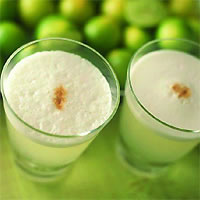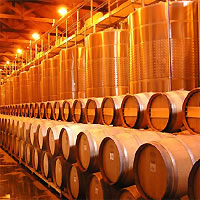Wine and Spirits in South America

Peru - Lima - Pisco
When you hear the name Pisco you automatically think of Peru, this liquor reigns supreme in the country and is made from fermented grape juice, technically a Brandy, aged to perfection in wood barrels. Pisco is the country’s official Spirit and one of the best ways to enjoy this liquor is in a Pisco Sour, or Pisco Punch, and it even has its own holiday! the first Saturday of every February is the official Dia del Pisco Sour Day. There are different types of grape varieties with different characteristics that make different Pisco’s; Puro is Pisco produced from only one grape variety, the local Quebranta grape, Acholado is Pisco produced from a blend of different grape varieties; and Mosto Verda is a rare type of specialty pisco distilled from partially fermented grape must wine.

Peru - Chicha de Jora
Chicha de Jora is a traditional emblematic Peruvian beverage that dates back to ancient Inca times. Each region in Peru makes its unique version of chica de jora, sold at markets, restaurants, and bars, and even made at home as well as used for cooking. Chica de jora is an ancient corn beer, it has been consumed for centuries throughout the Andes, it is served sweet or strong. A traditional Peruvian beverage made from jora corn which is fermented, it was the main beverage of the Inca nobility and was created by chance during the government of the Inca Tupac Yupanqui. The ceremonial beverage is served in the Peruvian Highlands during festivities in honor of the Incas such as the Inti Raymi.

Bolivia - Potosi - Singani
Singani is the signature liquor of Bolivia, made using the white Muscat grape of Alexandria. The homegrown spirit is close kin to Pisco, grapes are grown and picked in Bolivia, and the Spirit is distilled, bottled, and labeled as well. This is Bolivia’s oldest liquor and blends floral, fruity, and spicy notes for a crazy unique flavor. The Muscat of Alexandria grape has been produced in the country for nearly 500 years, it was invented in the mid-sixteenth century, it was created to satisfy the demands of the wealthy residents of Potosi, which was once the richest city on Earth as a mining outpost. Singani is a very potent, high-alcohol spirit and is special due to the wine used to make it uses only one specific varietal of grape, an ancient vine originally cultivated in Egypt and brought to the Americas in the 1500s by the Spanish colonists. The grapes are only made at altitudes of more than 5,000 feet, this allows the grapes to protect themselves from the elements with a thick skin where most of the flavor is contained, this is what gives Singani its uniquely rich aroma and taste.

Colombia - Aguardiente
Colombian Aguardiente is often referred to as Latin America’s moonshine, the national beverage of the country derived from sugar cane and infused with aniseed to achieve a distinctive flavor. Each region of the country produces its spin on the spirit, the name Aguardiente translates to “firewater” and is a very strong liquor, usually served neat and called Como debe ser. The liquor is said to have been created by the Quechua Indians, who prized an alcoholic beverage called guarapo for its bittersweet taste and warming effects. Aguardiente has a black licorice-inspired taste, crispy finish, and a creamy feel, similar to rum, it pairs well with grilled meat, hard cheese, tropical fruits, and fried bread. It is sometimes described as the country’s version of tequila, a culture-infused liquor, that is best enjoyed from tiny plastic shot glasses with water on the side.

Argentina - Buenos Aires - Fernet
Fernet is an Italian type of amaro, a bitter, aromatic spirit and one of the most polarizing distilled spirits in the world. This is the popular liquor in Argentina, it originates from Italy but became so popular that now Argentina consumes 3 times the amount consumed in Italy. A Fernando or Fernandito, Fernet con Cola is made using a mixture of amaro Fernet-Branca with Coca-Cola served in a tall glass over ice. The liquor has an acquired taste (bitter, sweet, minty, and herby) made from several herbs, and spices which vary according to the brand, but usually include myrrh, rhubarb, chamomile, cardamom, aloe, and saffron. It is usually served as a digestif after a meal, but can also be served with coffee and espresso, it contains 45% alcohol by volume. The World’s most famous Fenet dates back to 1845 when Bernardino Braca combined some 27 herbs and other ingredients with a grape distillate to create Fernet-Branca, it was created to help with digestion. The Fratelli Braca distillery is the only Fernet production facility outside of Milan, situated on the outskirts of Buenos Aires.

Brazil - Rio - Cachaca
Cachaca is Brazil’s version of rum (it's not rum), an indigenous Brazilian Spirit distilled from sugarcane juice with a sweet flavor of fruits and spices. The most famous cocktail made from Cachaca is the Caipirinha (Brazil’s national drink) which features the vegetal, funky, earthy, and fruity notes of the spirit with lime and sugar, there are so many versions to taste. Catuaba is an alcoholic tree-bark infusion that was first consumed by Brazil’s indigenous Tupi people, a potent aphrodisiac, and has antidepressant qualities used to treat insomnia, and anxiety, and used for improve memory function. This beverage remains true to the flavors of Brazil, filled with contrasting citrus, spice, savory, and a lightly sour nose when drunk neat.

Chile - Pisco
Terremoto is the real national drink of Chile, however, the Pisco Sour is the officially recognized drink of the country. A Chilean Pisco is a strong alcoholic drink with a similar smell to Vodka, both Chile and Peru claim this drink as their own. Pisco is the most popular drink in Chile, produced from Quebranta grapes grown in unique environments in the northern vineyards of Chile, specifically the Limari and Elqui valleys. After the grapes are carefully picked the juice is extracted and the fermentation process begins in large steel kegs. The sugar converts to alcohol with grape juice being transformed into wine. The distillation process takes six months to age in fine wood American Oak barrels. The most popular way to enjoy the drink is by making a Pisco Sour, a simple recipe made by mixing one egg white, some powdered sugar, and one part lemon or lime to three parts of chilled Pisco. .